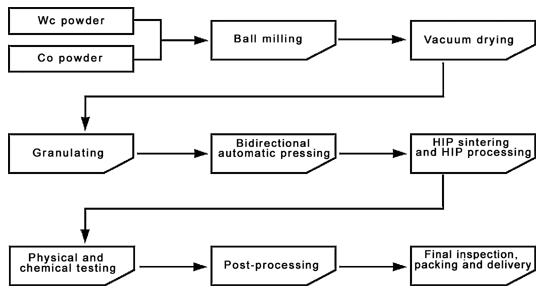1. Hardness: Normally, HRA and HV are used to indicate the hardness, but HRA is more commonly used. For WC-Co carbides, the hardness increases relatively as the cobalt content decreases and WC grain size reduces.
2. Strength: Cemented carbide is in the category of brittle materials. Its strength is normally evaluated by bending strength, compressive strength and fracture toughness, etc. and the simplest and most commonly used method is check its bending strength. In China, bending strength is obtained via 3-point bending test according to GB/T 3851 standard. Bending strength normally increases as the increase of the cobalt content, but after the cobalt content exceeds 15%, bending strength starts to decrease.
3. Density: Density is a reflection of the grade composition, and is an important factor to be controlled in production process. Redundant of insufficient carbon content can all be reflected by density. Carbide density decreases as the cobalt content increases, but it has nothing to do with WC grain sizes.
4. Magnetism: Cobalt is magnetic material and its rule of magnetization complies with magnetization curve of ferromagnetic materials. Therefore, tungsten carbide possesses magnetism. Magnetic property can reflect structural and compositional of carbide and so, it is also an important factor to be controlled in production process.
5. Porosity: Porosity indicates there are micro bores in carbide's microstructure of smooth surface. Micro bores in carbide product is very detrimental to its strength, and the pores are the origin of carbide destruction. The most effective way to eliminate and inhibit pores in carbide is to use sinter-HIP or HIP (hot iso-static press) Process.
Carbide manufacturing process
The production process for various grades of cemented carbide is basically the same, i.e. prepare powder burden powder mixing-pressing-sintering-post machining. Only some minor process parameter adjustments need to be done occasionally.
In the course of over 70 years of development and as basic theoretical research goes deeper internationally, carbide industry's equipment and technologies improved significantly. New technologies and equipment emerged in western countries in 1970s have become more and more popular in China's carbide manufacturing industry and are driving the development of carbide industry in China.
Powder mixing operation: Tumbling ball mill is gradually changing to blending ball mill, and roller screen granulation is gradually changing to spray granulation.
Pressing operation: As pressing machines become more precise, precision pressing has become the trend. Other new ways for forming carbide products are also emerged, such as vacuum extrusion and cold iso-static press, etc.
Sintering operation: The earliest method was to use hydrogen sintering furnace, and then, vacuum sintering and hot iso-static press furnace were adopted. The most revolutionary change was the emergence of sinter-HIP furnace, which made it possible to produce 100% dense carbide products.
Flow chart of cemented carbide manufacture
